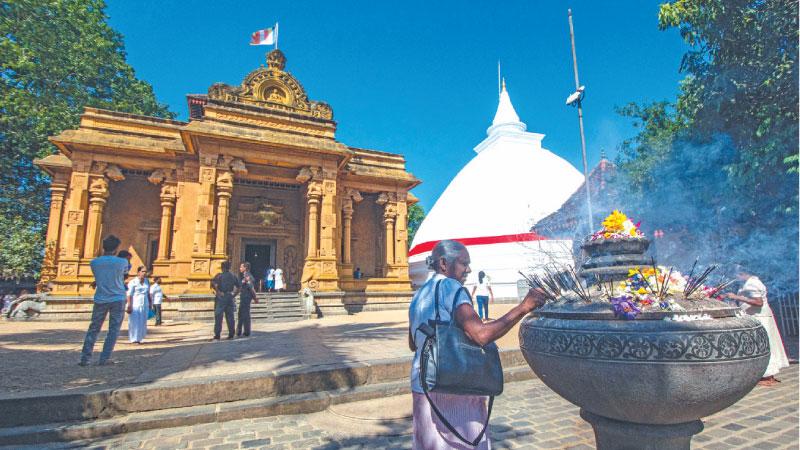
As we enter a new year and a new decade, images of incredible courage and resolution are imprinted in our minds. But most of the religious minded people gather at religious places to get blessings from their faith.
The most important centre of faith for Buddhists is at Kelaniya, ten kilometres northeast of the Colombo city and a short detour off the Kandy Road. Indeed, the Kelaniya Raja Maha Viharaya is said to be one of the three places in the island the Buddha made it a special point to visit.
The meandering Kelani Ganga flows serenely in front of the Kelaniya Raja Maha Viharaya, which has an attractive environment with scenic beauty. Passing the hustle and bustle suburb of the highly urbanised Kelaniya town, with memories of the Sinhala poem Upanda sita karapu pawu netha warak wandoth Kelaniye (the sins of a lifetime disappear if you worship once at the Kelaniya Temple), in my mind which was retold by my mother when I was a little boy, I started to climb the flight of steps to the Kelaniya Raja Maha Viharaya, which combines spirituality and tranquillity.
White clad devotees line up in front of vendors selling flowers to buy pink lotus. Some walk hurriedly to the temple with pooja offerings. This is the everyday life in the busy morning of this sacred area.
The Kelaniya temple has held a special place of reverence in Sri Lankan hearts. Whoever worships once at this sacred shrine would be blessed a thousand-fold and cleansed of a Samsaric lifetime of sin. Thousands of pilgrims, their hearts laden with faith and fervour, climb the steps to reach the upper platform where the temple sits. They offer baskets of sweet poojas and vibrant flowers before the Buddha image, Bo tree and dagoba as a mark of devotion to fulfil their vows.
Every day, the temple ground is a hive of activity with the devotees and saffron clad Bhikkunis who sit along with the lay on the sandy ground to recite stanzas. Some devotees carry pots of water around the Bo-tree shrine to offer the faithful, while some meditate silently.
According to legend, the unusual ‘paddy-heap’ shaped dagoba at Kelaniya marks the spot where the Buddha, on the request of a Naga king, Maniakkhika, sat on a ‘gem-studded throne’ to preach the Dharma to his subjects and convert them. It is ascribed to King Yatala Tissa of 3rd Century BC.
Legend says Gautama Buddha set foot in Kelaniya with a retinue of 500 enlightened (Arahat) monks on his third and final visit to Sri Lanka over 2,500 years ago, and it is said that He bathed in the Kelani Ganga, which flows close to the temple.
The modern vihara, built earlier this century, has a distinct elegance. Frescoes decorate its walls, telling stories of the Buddha, Buddhism in Sri Lanka, and the history of the Kelaniya Temple.
The geometrically patterned paintings on the ceiling in the main hall are fascinating. There are also three important Buddha images, one reclining and two seated. Rows of comical dwarfs and elephants, copied from Polonnaruwa’s Tivanka Image House, adorn the outer walls.
The temples premises are swarmed with devotees on Poya days especially on Duruthu Poya (full moon) in January, when an annual perahera proceeds from the ancient Vihara to celebrate the Buddha’s visit. It is a spectacle almost as gorgeous as Kandy’s Esala. It pours down the streets of Kelaniya and its environs, drummers drumming, torches blazing, dancers whirling, while the stately elephants move majestically carrying the Sacred Relics caskets.
